Overview
Here's what the Library can store:
- Paper
- Octavos
- Medleys
- Text Books
- Music Books
- Digital Records
- links to YouTube and other clips
- uploaded pdfs, docs, images, etc.
- Recordings
- Cds
- Dvds
- Cassettes
- Vinyl
Setting Up Your First Library
Clicking on the "Libraries" card from the Home page will automatically set up your first library, called "Home Library".
This library is mandatory, cannot be removed, and is based on the presumption that all Choral Directors maintain some type of reference library at home with single/Director copies of the music that is being prepared at school. As described later under XXXXXX, you can instruct the system to automatically save a record in the Home Library every time you add a new item to the school library.
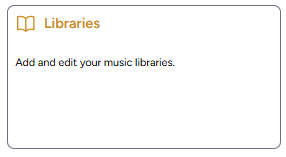

School Library
Clicking the green plus-sign on the right side of the page will open a form to create a new library; likely your school library.
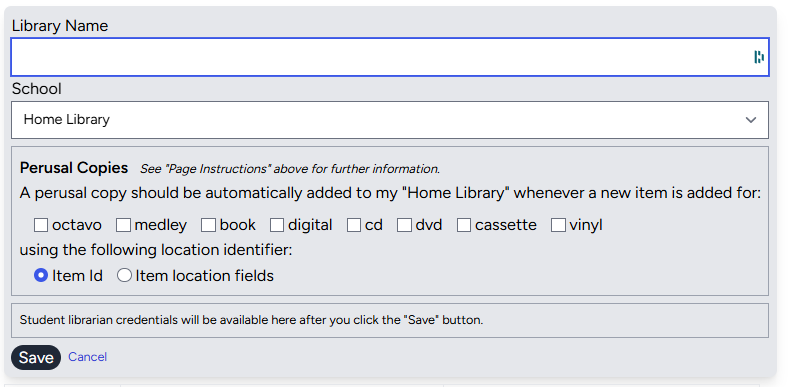
- Enter the name of the library you are creating. Shorter is better, but be as descriptive as needed.
- Select a school. The form will default to the "Home Library" value, but click the drop-down box to display any school that you have set up in the Schools application.
- The "Perusal Copies" section is where you will set up the default behavior for automatically
creating Home Library copies of any item added to this library.
- You can choose which type of library item you want to have automatically copied to your Home Library by clicking the appropriate check box, or leave them all blank if you don't wish to have any items automatically copied to your Home Library.
- You can choose to have the system use the Item Id for its default location value, or to use whatever values you enter for the item's location in the School Library. A fuller description of the Location values is found below at XXXXX.
- These default setting can be overridden on an item-by-item basis when entering an item through a simple checkbox.
-
The "Student Librarian" section will be automatically created after you save the form.
- If you have a student librarian, the section will provide you with a fake email address and random password for use by the student librarian. This will allow the student librarian to log into TheDirectorsRoom.com with access to add and edit your library items for this specific library but the student librarian will not be able to access any other parts of TheDirectorsRoom.com nor will they be able to remove any items from this library.
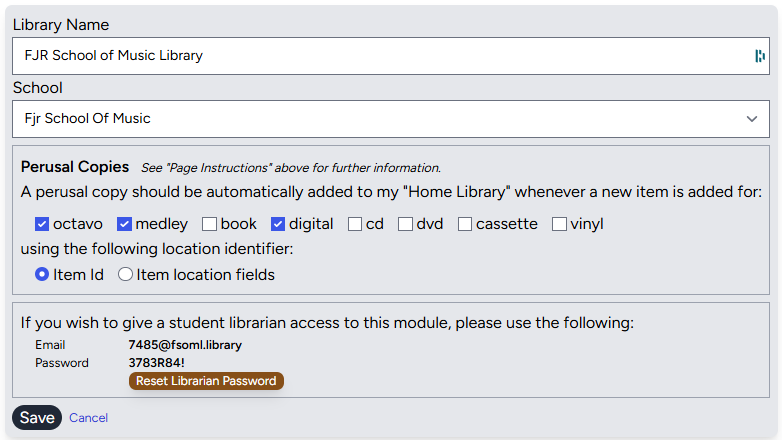
Clicking on the indigo "Edit" button from the Libraries page will display the image above.
Clicking the Library name (ex. FJR School of Music Library) will display the table of stored library items as displayed in the image below.

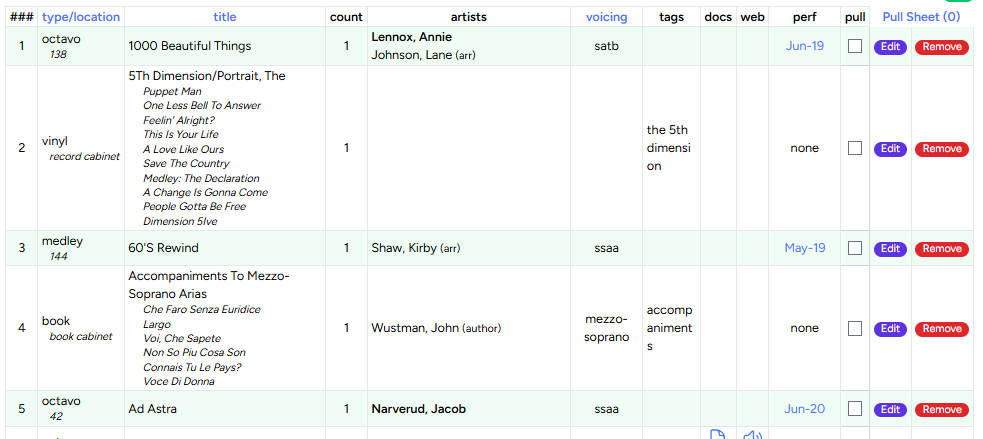
Global v. Local

At the top of the page, you will see the label "Library:" with two option buttons; one with the name of your library and the second named "Global".
The button with your library's name will display the items in your library.
The "global" library is a unique feature of TheDirectorsRoom.com Library to provide you with a view into what other directors are using in their libraries and, by virtue of the number of times a piece is listed, the general popularity of a piece.
The button with the Global name will display ALL of the items in the global library, including your library's items. The "global" display differs from your library's display as follows:
-
A column titled "my" is added to the front of each row.
- Items from your library will be highlighted with an asterisk (*).
- Your items will display in black font with all other items in a lighter shade of gray.
- Only docs marked as "shareable" will display under the "docs" column. This includes your library's docs which WILL display in your library's view but will be hidden in the global view.
- The "perf" date will display, but ONLY your items will link to programs.
- The "pull" column checkbox is only displayed on your items.
- You are able to edit and remove your items, but these buttons will be removed from items in other libraries.
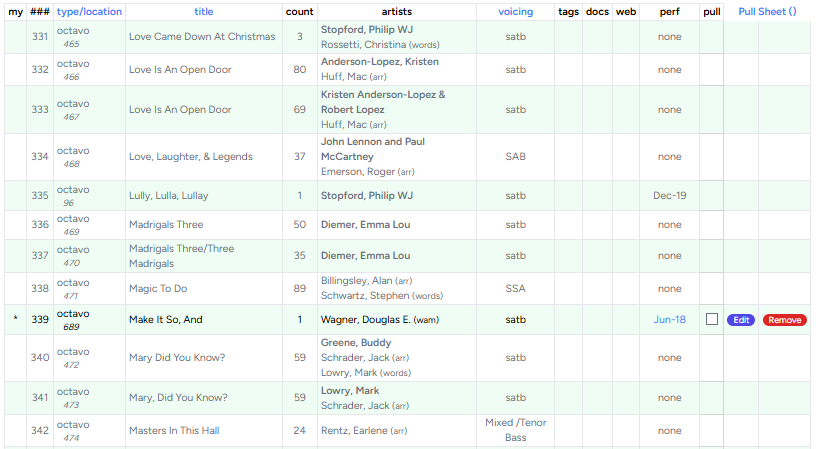
Library Items
Clicking on the Library name
 from the Libraries (see image above) page will display
the following image.
from the Libraries (see image above) page will display
the following image.

Navigation
Before diving into the table, let's talk about the information above the table:
- Search Bar
- Found at the top of the section with the placeholder "Search title, artist name or tag",
you can use the search bar to quickly scan your list of library items to find a
specific item using a portion of the item's title, artist name, or tag value.
- "Artist name" includes any composer, arranger, words-and-music, words, music, choreographer, or author's name.
- As an example, entering "don" (without the quotes) in the Search bar would display the
library items in the image below (if you had these in your library, of course):
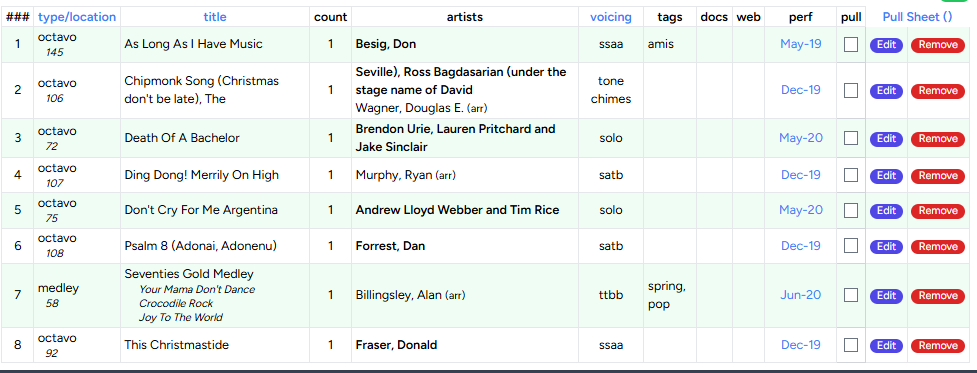
- Found at the top of the section with the placeholder "Search title, artist name or tag",
you can use the search bar to quickly scan your list of library items to find a
specific item using a portion of the item's title, artist name, or tag value.
-
Download Button

- Located across from the Search bar, click this button to download your entire library with all details into a csv file.
- You can use this for backup purposes or to perform more specialized analysis as needed.
-
Table Filters

-
Found below the Search bar, there are two filters identified by drop-down boxes
defaulting to the word "ALL":
- Voicing Filter: returns all library items for the selected voicing choice (ex. SATB, TTBB, etc.)
- Type Filter: returns all library items for the selected type choice
(ex. Octavo, medley, book, etc.)
- Note that there are type grouping for Paper (octave, medley, and book), and Recordings (digital, cd, dvd, cassette, and vinyl).
-
Found below the Search bar, there are two filters identified by drop-down boxes
defaulting to the word "ALL":
-
Table Columns
- Column headers type/location, title, and voicing are highlighted in blue and can be clicked to sort the table by that column.
- "Pull Sheet" is a link that displays a pdf of pull selections; more on that below.
- ###: Simply a row number.
-
type/location: Displays the type of the
library
item and it's location code. (More on the location code below.)
- Item types are: octavo, medley, book, digital, cd, dvd, cassette, and vinyl.
-
title: Displays the title of
the library item. Note that all titles are automatically formatted as a title with all
words capitalized.
- Note also that items containing multiple songs (medleys, music books, recordings), all entered songs will be displayed here AND will be included in any search results.
- As an example, "Seventies Gold Medley" is included in the search results for "don" because a song in the medley, Your Mama Don't Dance, includes the fragment "don".
- count: Displays the count of items available in your library.
-
artists: Displays the artists associated
with the library item.
- Artists are: composer, arranger, words-and-music, words, music, choreographer, and author.
-
voicings: Displays the voicing
(SATB, SSA, TTBB, etc.) of the library item.
- If the item has no voicing (ex. text book) or multiple voicings (ex. recording), the system will default to "none" or "various" may be selected.
-
tags: Displays all tags that have been
used for the library item.
- Note that this will include tags entered by other choral directors so that you might receive additional benefit of the collective mind.
-
docs: Displays a clickable document icon
 that opens the referenced document.
that opens the referenced document.
- Note: Documents can be any digital asset up to 4Mb in size. This includes pdfs, docs, spreadsheets, images, small sound files, etc.
- Hovering over the doc icon will display the label provided for the document.
-
web: Displays a clickable speaker icon
 that opens a tab to the referenced web link.
that opens a tab to the referenced web link.
- For example: A link to a YouTube performance.
- Hovering over the speaker icon will display the label provided for the link.
-
perf:
If you have created programs using the Programs application,
this column displays clickable date(s) for every program where this item is
performed.
- Clicking the date will take you to that program.
-
pull:
Click the checkbox under the "pull" column to create a pull sheet for researching
multiple library items. The pull sheet will include key information for finding
the item in your library.
- Click the "Pull Sheet" link above the "Edit" and "Remove" buttons to open the pull sheet pdf.
-
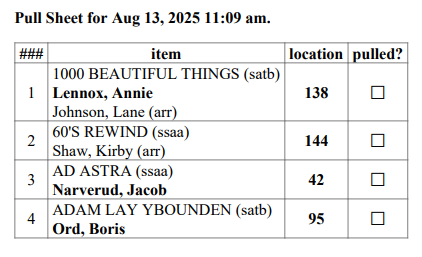
-
Edit and Remove buttons:
Click these buttons to, respectively, Edit or Remove the item from your library.
- Note: The "remove" button will ALWAYS display an "Are you sure?" check to ensure that you meant to click that button!
Item Form
Clicking the green plus button
 or indigo "Edit" button
or indigo "Edit" button
 from the Library Items page will display
the following form.
from the Library Items page will display
the following form.
Depending on the item type selected, (octavo, medley, book, digital, cd, dvd, cassette, vinyl) the system will automatically add or remove sections to accommodate the item's needs. The image below displays the Octavo input form, containing the most common fields for all item types except digital.
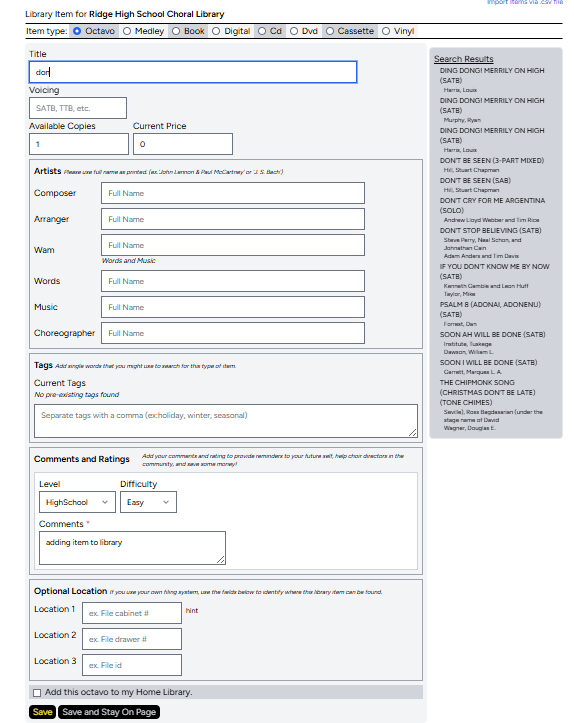
Item Type Selector

Select the item type to be added by clicking the appropriate radio button.
Title

Enter the name of the library item. All items of the same item type with matching titles will be displayed in the "Search Results" box on the right-hand side of the page. (Shown above are octavo library items matching "don" in the title.)
Note that this search is across the system so that you can leverage input from other choral directors to save time and avoid having to retype information that is already in the system! Clicking on a link from the "Search Results" section will populate the form with known values and allow you to continue to update other fields.
Voicing
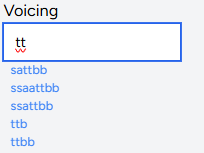
By entering a few letters, the system will automatically find and display the matching choices. You can either continue typing or click one of the displayed voicing to complete the field.
Available Copies & Current Price

Available Copies: Enter the number of copies available in your library. Note that the number must be positive and greater than zero. The system will default to one.
Current Price: Enter the price per item paid, without the dollar sign. Note this this field can be left blank.
Artists
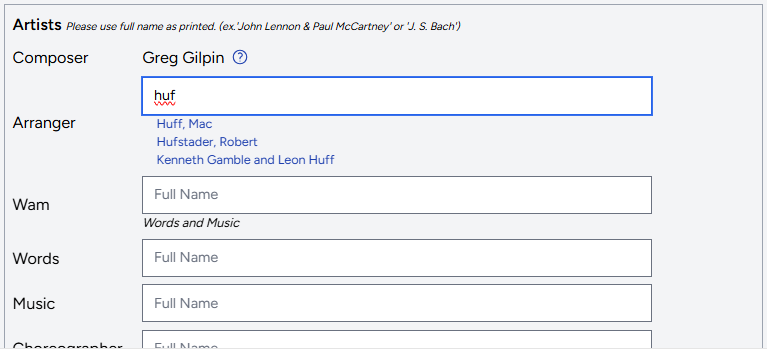
Enter the artist's name(s) in the appropriate slot as described in the physical item (octavo, medley, book, etc.) If there are multiple artists for a single artist type, include all names separated by a comma with the final artist preceded by an "and". For example:
- John Lennon and Paul McCartney
- Ben E. King, Jerry Lieber, and Mike Stoller
By entering a few letters, the system will automatically find and display the matching choices (see "huf" above). You can either continue typing or click one of the displayed artist names to complete the field.
Note in the example above that the composer, Greg Gilpin, is displayed but not editable.
Editing is permitted if a) you have originally entered the value, and b) no other choral
director is also using the value. In this case, Greg Gilpin is used by another choral director
(i.e. has accepted the name as correctly spelled) and is not editable. Hovering over the
question mark icon
![]() also describes this condition.
also describes this condition.
Locations

Every good library is designed to make a stored item easy to find. That's the whole point: organizing a massive amount of similar looking items in a way that makes retrieval easy and accurate.
Locations 1-3: are provided to accommodate whatever system you are currently using by giving you three fields into which that system can be recorded. When played back, the system will report the fields as separated by a dash.
For example: If your system is based on file cabinet number (ex. 3), file drawer number (ex. 2), and file id (ex: c), you could put each value into its respective box, which the system would return as 3-2-c.
This location value would then be displayed on the library items table (under the type/location column) and on the pull sheets so that you will always be able to quickly locate the physical copy.
If, for whatever reason, your current system isn't working for you, consider letting TDR Library simply
assign a number to the item.
This happens automatically if you leave the location fields blank!
Regardless of which system you use, finding an item's location is as simple as using:
- TDR Library's search and filter functionalities to find the pieces or types of pieces you're looking for,
- Click the checkbox under the "pull" column,
- Print the pull sheet using the pull-sheet link,
- Pull each piece from your cabinets using the location code value.
Medley and Recordings Selections

Medley, CD, DVD, cassette, and vinyl input types have an additional section called "* Selections" to allow choral directors to document the individual songs contained within the medley or recording.
After entering the title in the "Song 1" slot, more slots will appear to allow you to enter as many sub-selections as needed.
Digital Items
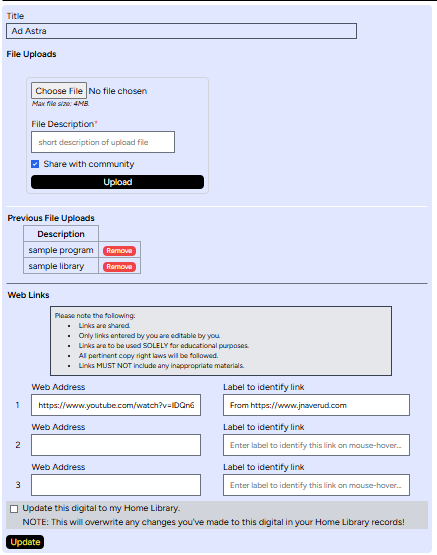
The digital item type allows you to upload digital files (pdfs, image files, docs, spreadsheets, etc.) for quick future reference and add web links to performances on the web (ex. youtube clips).
Only the title field will initially display. Enter a title and then click an item from the Search Results on the right-hand side of the page. When a title is selected, the File Uploads, Previous File Uploads (if any) and Web Links fields will display.
Note that the "Remove" button on the Previous File Uploads section will ONLY display for the teacher. Student librarians are prohibited from removing items.
After uploading, a document icon
![]() will display for each upload under the "docs" column and using the value entered in the
"File Description" field as a label.
will display for each upload under the "docs" column and using the value entered in the
"File Description" field as a label.
After adding a new web address, a speaker icon
![]() will display for each web link under the "web" column and using the value entered in the
"Label to identify link" field as a label.
will display for each web link under the "web" column and using the value entered in the
"Label to identify link" field as a label.

Consider this section as advise to your future-self. Five, ten, or fifteen years after initially performing this item, you might be tempted to do it again. What would be helpful to remember about the piece?
Alternately, if another choral director was considering this piece, what advice would you give that choral director about your experience with the song? This section is designed to capture value for both of those situations.
Rating: This does not display when adding a new library item but will display on Editing the item and in the Programs application. Rate the item on a scale of 1-5, with 1 as "once and done" and 5 as "Every student should sing this!"
Ratings are planned to be used in the future to give a global "score" of how choral directors rate this library item.
Level and Difficulty: From your subjective viewpoint, what is the choir's skill-level (elementary through professional) appropriate for this item and, within that skill level, how difficult is it (easy to hard)?
Comments: This is an open content field for reminders to your future-self and to other members of the choral community.